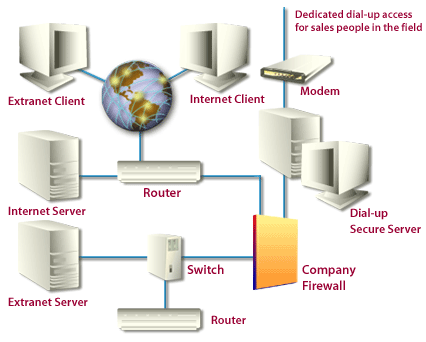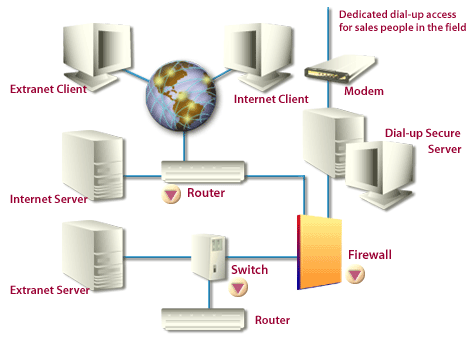| Lesson 5 | Network hardware and software |
| Objective | Describe hardware and software network connection devices. |
Network Hardware and Software
Networks are composed of hardware and software components. Each hardware and software component has a different function to perform. However, network operating system (NOS) software makes all the different components work together as a single network. NetWare, Solaris, Linux, AIX, and Windows NT are examples of NOS software. The figure below is a diagram of a simple network.

Bridge
A bridge is a network device that's used to segment one network into two segments. Isolating the traffic into separate segments eases network traffic congestion. The bridge accomplishes this by reading the unique hardware address (called the Media Access Control) of each network device to determine the appropriate segment. It performs the same functions as a repeater.
Gateway
A gateway comprises hardware and software that acts as a translator between networks using incompatible communications protocols. Gateways are commonly used to connect networks of personal computers to minicomputer or mainframe based hosts.
A gateway is a node on a network that serves as an entrance to another network. In enterprises, the gateway is the computer that routes the traffic from a workstation to the outside network that is serving the Web pages. In homes, the gateway is the ISP that connects the user to the internet. The gateway is also associated with both
- a router, which use headers and forwarding tables to determine where packets are sent, and
- a switch, which provides the actual path for the packet in and out of the gateway.
Repeater
A repeater receives and transmits signals and duplicates them onto another network segment. Repeaters extend the maximum length of a segment and increase the number of possible connected devices.
Network Hardware and Software
Networking hardware may also be known as network equipment or computer networking devices.
Units which are the last receiver or generate data are called hosts or data terminal equipment and all these terms refer to devices facilitating the use of a computer network. Specifically, they mediate data in a computer network.
Units which are the last receiver or generate data are called hosts or data terminal equipment and all these terms refer to devices facilitating the use of a computer network. Specifically, they mediate data in a computer network.
Range
Networking hardware includes
Taking a wider view, mobile phones, PDAs and even modern coffee machines may also be considered networking hardware. As technology advances and IP-based networks are integrated into building infrastructure and household utilities, network hardware will become an ambiguous term owing to the vastly increasing number of "network capable" endpoints.
- gateways,
- routers,
- network bridges,
- switches,
- hubs, and
- repeaters.
- data center equipment (such as file servers, database servers and storage areas),
- network services (such as DNS, DHCP, email, etc.) as well as
- devices which assure content delivery.
Taking a wider view, mobile phones, PDAs and even modern coffee machines may also be considered networking hardware. As technology advances and IP-based networks are integrated into building infrastructure and household utilities, network hardware will become an ambiguous term owing to the vastly increasing number of "network capable" endpoints.

- A router connects dissimilar networks and forwards data. Routers filter traffic based on protocol-specific software addresses, sources, and destination port numbers. Routers are more flexible than bridges but require more processing power.
- A firewall blocks a specific type of data or prevents data from specified sources from entering the network. Thus, malicious entities are barred from infiltrating a network.
- A switch connects network segments with high-usage percentages. Switches offer higher performance than bridges or routers and are a lower cost alternative to them. Switches are used to create virtual LANs.
Solution In a Box
Many large companies are choosing a low-cost Internet access solution called Solution-in-a-box. Solution-in-a-box systems provide networks with a single Internet connection. These devices are typically black boxes with a single phone line connection and a single network connection.
In the next lesson, the different types of servers and their functionality will be discussed.
In the next lesson, the different types of servers and their functionality will be discussed.
[1]Hub: A hub (or concentrator) interconnects multiple devices in a network. Hubs enable distribution of information among connected devices.